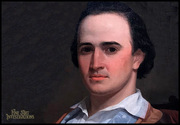In the “Style of George Caleb Bingham” was the description of a portrait sold at auction several years ago. The winner bidder asked Fine Art Investigations if George Caleb Bingham created Man in a Blue Vest?
Bingham?
No. Not only did the technique differ, the painting had an entirely different sensibility. The dark-haired subject’s open collar, his dressing gown worn over his gorgeous waistcoat all gave the impression that the sitter was a southern planter posing on a summer morning before the day grew hot. Bingham painted many southern planters – he was southern himself –but none so emphatically called out the subject’s status. He rarely painted such an informal a portrait. The closest example is John A. Trigg. Can you see the differences in technique, especially the eyes? Can you feel the differences in the way the artists approached the representation of another human being?


Then who?
If not Bingham, then who did paint Man in a Blue Vest? Fine Art Investigations needs at least one good clue to identify an artist. The only clue for Man in a Blue Vest was mention in the auction description of an unpictured “Old label from Louisville Kentucky.” Yet the painting itself supplied more hints. The height of the subject’s collar, if raised, and the cut of his waistcoat revealed that the sittings occurred in the early 1840s. The exquisite rendering of the waistcoat delivered the most significant hint. Most portraitists, if not being paid for a full-length representation, devoted their time to depicting the face and less time to the clothing. The equality of both in Man in a Blue Vest suggested two artists at work. The obvious team was Theodore Sidney Moise and Trevor Thomas Fowler.
Moise and Fowler in Kentucky
Theodore Sidney Moïse was Jewish, born in Charleston, South Carolina. Trevor Thomas Fowler was an Irish immigrant. Leaving their families behind, they traveled together throughout the south. In the early 1840s their travels took them to Kentucky. At the home of Orlando Brown in Frankfort, Kentucky, now the Liberty Hall Historic Site, they portrayed Orlando Brown, his sons and their dog. The similarities, particularly in eyes and attitude, are striking:

Liberty Hall Historic Site
Frankfort, Kentucky


Liberty Hall Historic Site
Frankfort, Kentucky
All Moïse scholars approached agree with the attribution to Moïse and Fowler. But, without more clues, the identity of Man in Blue Vest remains a mystery.
Conservation and a Perfect New Home
The new portrait owner provided the conservation needed to preserve the portrait for more years to come. He sold Man in Blue Vest to artist Andrew LaMar Hopkins. Even nameless, the portrait may find new life in the oeuvre of Hopkins’ “historical folk outsider art.”((“Andrew LaMar Hopkins: Revisiting the Dense and Lively Creole Culture of New Orleans, On Art and Aesthetics, June 23, 2020, https://onartandaesthetics.com/2020/06/23/andrew-lamar-hopkins-revisiting-the-dense-and-lively-creole-culture-of-new-orleans/, accessed May 2021.)) In the period French Empire frame of Andrew Hopkins, here is Man in Blue Vest:

Visit our Services page for more information about Artist Identification.

